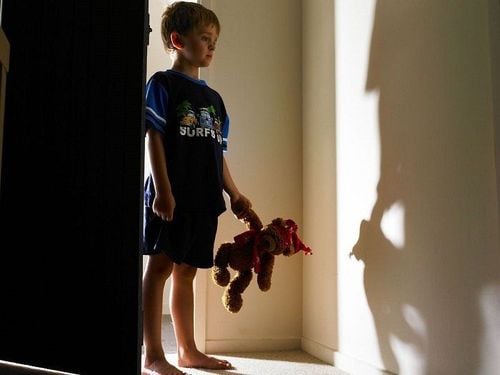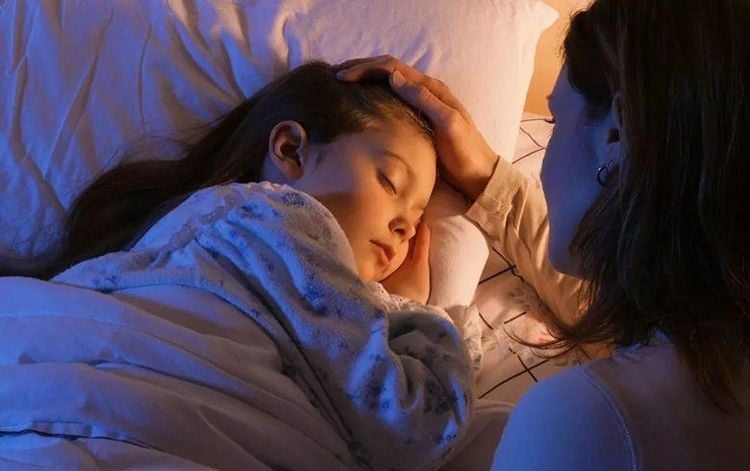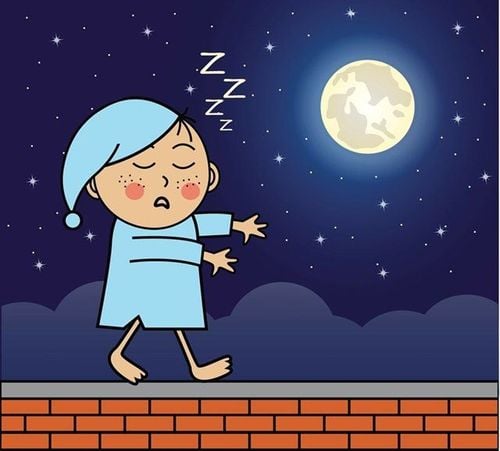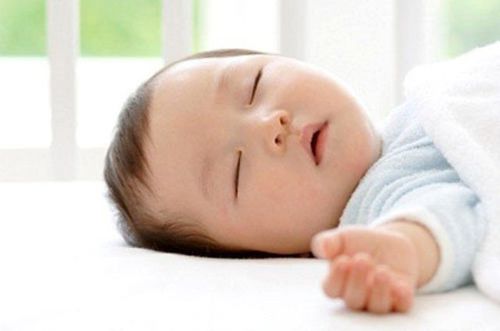This is an automatically translated article.
Sleepwalking is a fairly common condition in children. Sleepwalking by itself is not harmful, but it can lead to dangerous situations for children because sleepwalking children will not be awake and may not realize what they are doing. Children can walk down the stairs or open the door to the balcony, ... these are extremely dangerous situations, parents need to pay attention to prevent children.1. What is sleepwalking in children?
Sleepwalking is very common in children. Sleepwalking is a disorder that causes babies to get up and walk while they are asleep. At this time, the child is not aware of his actions. This condition is also known as sleepwalking.Sleepwalking often occurs when a child is transitioning from a deep sleep to a shallower stage or waking up. Your child may not be able to answer your questions while in a sleepwalking state and often has no memory of the condition when he wakes up. In some cases, the child may speak, but often in sentences that do not make sense.
Sleepwalking mainly occurs in children, and is most common between the ages of 4 and 8 years old. However, adults can also experience sleepwalking.
Most children start sleepwalking between 1 and 2 hours after falling asleep. Sleepwalking episodes usually last 5 to 15 minutes. It is difficult to wake a child while sleepwalking. If awakened during this time, the child may feel groggy and disoriented for several minutes.
This behavior is usually harmless and most children grow up and lose the condition. However, it can be dangerous if the child is not protected. It is important for parents to protect their children from potential injury situations that occur when a child sleepwalks.
Sleepwalking is more than just walking, children can have other behaviors such as:
Harmless behavior: Like sitting up. Potentially dangerous behavior such as: Wandering outside. Inappropriate behavior such as: Opening a closet door and urinating in it.

Mộng du là một tình trạng rối loạn, khiến trẻ đứng dậy và đi bộ khi đang ngủ
2. What causes sleepwalking?
So far, experts don't know exactly what causes sleepwalking, although it seems to run in families. Sleepwalking can start anytime after your baby starts to walk or crawl, and at least 15% of young children will sleepwalk at some point.Sleepwalking usually happens within an hour or two of a baby falling asleep, when your baby is in the deepest stages of sleep, or not REM (rapid eye movement). Sleeping in unfamiliar places, lack of sleep, or a high fever can trigger sleepwalking.
A sleepwalking child appears to be awake, even though it is not. His eyes will open, and he may even continue a conversation, even though it probably won't make much sense. Children may wander around the house with no purpose at all; Common behaviors include dozing off in a closet or confusing it with the bathroom.
There are a number of factors that can contribute to sleepwalking in children, including:
The child is tired or sleep deprived. Children have irregular sleeping habits. The child is stressed or anxious. Children have to sleep in a strange place. The child is sick or has a fever. Due to the effects of certain drugs, including tranquilizers, stimulants, and antihistamines. Children born into families with a history of sleepwalking. Although uncommon, sleepwalking can be a symptom of an underlying medical condition. These conditions can include:
Sleep apnea : is when a person stops breathing for a short time during sleep. Night terrors: Night terrors are dramatic nightmares that occur during deep sleep. Migraine headache . Restless leg syndrome (RLS). Head injury
3. Symptoms of sleepwalking in young children
Sleepwalking usually occurs around the beginning of the night's sleep, it cannot happen during a nap. Sleepwalking may occur infrequently or frequently in a child.Walking while sleeping may be the most common sleepwalking symptom, but there are other actions associated with this condition. Symptoms of sleepwalking may include:
The child sits up in bed and repeats the movements. Children wake up and walk around the house. Babies may talk or mumble while sleeping. Your child does not respond when you want to talk to him. Child makes clumsy movements Child may urinate in inappropriate places such as closets, corners of the house, etc. Children may perform behaviors that are frequent or repetitive throughout the day, for example like opening and closing doors, getting dressed. Children may become more violent during the period immediately after waking or sometimes during sleepwalking. Children can be injured by falling down stairs or jumping off a balcony.

Chứng mộng du thường xảy ra vào khoảng đầu của giấc ngủ ban đêm, nó không thể xảy ra trong giấc ngủ ngắn
4. Is sleepwalking dangerous for children?
Sleepwalking in itself is not harmful. But sleepwalking can lead to dangerous situations because sleepwalking children are not alert and may not know what they are doing. Some of the dangerous situations that can occur when a child sleepwalks is:Children hurt themselves, especially when they walk near objects or stairs, wander outdoors, eat something is not appropriate when sleepwalking. Rarely do children hurt others while sleepwalking. Sleepwalking is not usually a sign that something is wrong emotionally or psychologically. Sleepwalking does not cause any mental harm to the child.
5. When does a child sleepwalking need to see a doctor?
Episodes of sleepwalking that occur only occasionally are usually not a cause for concern and usually go away on their own. You can mention sleepwalking when you bring your child in for a routine check-up or when you go to the doctor for some other reason.However, you should talk to the doctor about your child's sleepwalking if:
Sleepwalking occurs frequently: 1-2 times a week or several times a night. Sleepwalking leads to behaviors that are dangerous or can cause injury to the child and others. Sleepwalking in children significantly disrupts the sleep of family members. Leads to symptoms of excessive daytime sleepiness or other functioning problems. Sleepwalking continues into the teen years.

Trong trường hợp mộng du dẫn đến các hành vi nguy hiểm hoặc có thể gây thương tích cho bản thân trẻ và người khác, bạn nên đưa trẻ đến gặp bác sĩ
6. Diagnosis of sleepwalking in young children
Often, a doctor can diagnose sleepwalking based on other family members' accounts of a child's behavior. The doctor may conduct a physical and psychological examination of the child to rule out other conditions that may be causing sleepwalking. If sleepwalking in a child is caused by a medical condition, then the child needs to be treated for these conditions.If your doctor suspects another sleep problem, such as sleep apnea, they may order a sleep study. A sleep study involves children spending the night in a sleep lab. Electrodes are attached to certain parts of a child's body to measure heart rate, brain waves, breathing rate, muscle tension, eye and leg movements, and blood oxygen levels. Cameras can also be used to record the child as they sleep.
7. Treatment of sleepwalking in young children
Sleepwalking usually does not require treatment. If sleepwalking is troubling your family, your doctor may recommend using a technique called scheduled wakefulness. This technique involves monitoring your child for several nights to determine when sleepwalking typically occurs and then shifting your child from sleep 15 minutes before the expected sleepwalking. This can help re-establish sleep cycles and control sleepwalking behaviour.If sleepwalking causes dangerous behaviors or extreme fatigue, your doctor may prescribe medication, such as benzodiazepines (a psychostimulant commonly prescribed to treat anxiety), or an antidepressant. cold.
Do not try to wake your child if you see him sleepwalking. Instead, gently guide your child back to bed. If you try to wake a child who is sleepwalking, this can make the condition worse.
Your child won't remember the event the next morning, so don't recount it. Talking about sleepwalking can be scary for your child before bedtime.
Parents can take safety measures around the home to help keep a child sleepwalking safe. Include the following measures:
Close and lock all doors and windows in your home at night. Install alarms on doors and windows or install locks out of your child's reach. You need to get rid of items that could be a tripping hazard. You need to remove sharp and fragile objects around your child's bed. Do not let your child sleep on a bunk bed. Install safety doors in front of stairs or doors. Lower the temperature of the hot water tank to avoid burns. Keep the keys out of your child's reach.

Nếu mộng du gây ra các hành vi nguy hiểm hoặc mệt mỏi quá mức, bác sĩ có thể kê đơn thuốc
8. Sleepwalking prevention in young children
When you find out that your child is sleepwalking, you can help them develop good sleep habits and relaxation techniques to help prevent sleepwalking.Try the following to help prevent sleepwalking:
Make sure your child goes to bed at the same time every night. Establish a relaxing bedtime routine for your child, such as taking a warm bath or listening to soothing music. You need to create a dark, quiet and comfortable sleeping environment for your baby. Reduce noise when your baby is trying to sleep. Limit your child's fluid intake before bed and make sure your child clears the bladder before bed. Avoid caffeine and sugar before bed. Psychological Clinic - Vinmec International General Hospital has the function of examining, consulting and outpatient treatment of psychological and health problems, including sleep disorders. With modern equipment, Vinmec Psychological Clinic is currently cooperating with experienced professors and experts.
Along with the combination of implementing psychological tests, intensive psychotherapy for diagnosis and treatment, in order to bring the best medical examination and treatment effect.
If you have a need for medical examination with experienced pediatricians at Vinmec, please book an appointment on the website to be served.
Please dial HOTLINE for more information or register for an appointment HERE. Download MyVinmec app to make appointments faster and to manage your bookings easily.
References: healthline.com, babycenter.com, mayoclinic.org, webmd.com, kidshealth.org












